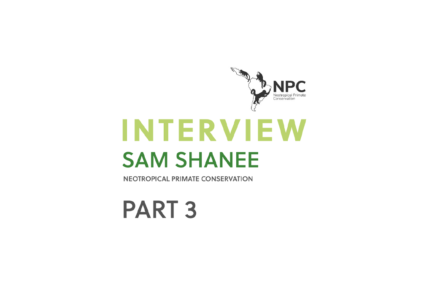Our Newsletter editor, Noga Syon, is tracing the woolly monkey!

In 1802, someone who will forever remain lost to history encountered a primate with a furry, mahogany coat and a yellow patch at the end of its tail somewhere in the cloud forests of the Peruvian Amazon. We can only imagine the rest of the story: this person must have hunted it, perhaps drawn to its thick, woolly coat. Maybe they skinned it themselves, and maybe they sold it.
I do not blame this person: little was known about conservation, and the hunter was a local, who saw this unique species quite often. What we do know is that in 1812, the German geographer Alexander von Humboldt encountered that very skin, used as a mule saddle, and named the animal to which the skin belonged Simia flavicauda, under the false belief that it was a species of howler monkey.
That was the first scientific documentation of the Yellow-tailed Woolly Monkey — and the last one for over a century: only in 1926 was the species scientifically documented again, this time by ornithologist Russell W. Hendee. Hendee captured three individuals of the species and took them to the Natural History Museum in Lima. For almost half a century after that, science found no trace of this elusive primate and believed it to be extinct.
Rediscovery
The Yellow-tailed Woolly Monkey was rediscovered by Western science during a 1974 expedition led by an American, Dr. Russell Mittermeier, and a Peruvian, Dr. Hernando de Macedo-Ruiz.
They entered the Andean forest with the intention of finding this particular monkey, as new roads had been opened into the remote habitat in the cloud forest. Already on their way to the forest, while taking a ride on a truck with locals, Mittermeier and Macedo-Ruiz came upon a skin of what was undeniably a Yellow-tailed Woolly Monkey, confirming to the researchers that the species indeed still existed. Their hike through the forest was fruitless, but they found a live Yellow-tailed Woolly Monkey upon returning to the village, where it was kept as a pet.

Two years later, a group of Yellow-tailed Woolly Monkeys was sighted in the wild, as described by expedition members Gary R. Graves and John P. O’Neill:
They were first noticed resting in a spot of midafternoon sunlight in the epiphyte-laden forest canopy approximately 25 m above the trail. Two of the more visible individuals were grooming themselves while reclining on limbs; a third was resting within an extremely large bromeliad. To draw them closer, Graves “squeaked” loudly on the back of his hand. The adult male quietly descended to a horizontal limb approximately 8 m above the trail and watched as Graves took notes. The deep mahogany and black pelage, whitish-gray muzzle, and straw-yellow tail stripe and scrotal tuft of the animal presented a striking pattern in the filtered sunlight.
It was not until 1983 that an individual of this species was caught live on camera in the wild, also by Dr. Mittermeier, who is an advocate for their conservation to this day. Watch this footage from the 7:20 min mark.
While the adjective “woolly” may evoke the image of the woolly mammoth stomping across the frozen tundra, the Yellow-tailed Woolly Monkey climbs and leaps among the trees in the Peruvian cloud forests. Its fur not only protects against the cold in the high elevations of its natural habitat, but also against the sun, rain, and insect bites. The Yellow-tailed Woolly Monkey was deemed Endangered by the IUCN Red list in 1982 and Critically Endangered from 1996 to this day. One of the world’s 25 Most Endangered Primates — due to habitat loss (around 50 percent of their habitat is already lost!), low birth rates, and hunting, including for the illegal pet trade — the Yellow-tailed Woolly Monkey’s numbers have rapidly declined. But let’s keep tracing the woolly monkey!
A cause for optimism
Back in 2007, a group of friends with a shared passion for conservation established Neotropical Primate Conservation, or NPC, in Peru. When looking for areas to protect, they sought out forests where this particular monkey, endemic to Peru, was known to inhabit. Local communities informed them of an area of forest where Yellow-tailed Woolly Monkeys were abundant, and indeed, that area seemed to have an encouraging number of individuals of this Critically Endangered species.
But the real surprise came when the group returned home: zooming in on their pictures, they found that a spider monkey was part of a group of Yellow-tailed Woolly Monkeys! Nothing was known about the interaction between these two species, and seeing them nearby is extremely rare, let alone as part of the same group.
That unique location, Peroles, is one we invite you to vote for to protect in TiME’s 2023 campaign. If selected by TiME members, the land will be purchased and managed by local community members, together with NPC Peru, which also helps manage Sun Angel’s Gardens and El Toro Forest, our success stories from 2017 and 2016, respectively. Since the beginning of NPC’s work in Peroles, the population of Yellow-tailed Woolly Monkeys has in fact increased — by natural population growth rather than immigration — making it the safest place for the conservation of this species and a perfect location for researching its behavior. Purchasing this area can be the culmination of the 200-year-old story of this elusive species, in which we can guarantee the survival of their habitat in the rapidly changing Peruvian Andes, which is facing constant threats of deforestation and hunting.
New risks
The work of NPC Peru is not limited to conservation. Keeping a close connection with local people is imperative to its mission; most notably, promoting awareness of the consequences of hunting, which is semi-legal for personal consumption, and of deforestation. NPC also works in schools and assists locals in generating sustainable means of income and in maintaining nurseries for growing trees from native seeds and seedlings.
As long as the land is owned by the people who work with NPC, the land is protected, NPC is allowed to work there, and guides are provided to NPC when needed. “Before there was cell reception in the village,” Sam Shanee, founder and project director of NPC, tells me, “I would receive outside phone calls to a central phone. They used to go to a central location, and call me by megaphone: “El gringo que cuida los monos” (“the foreigner who looks after the monkeys”).
Until today, Peroles had been owned by locals who have worked with NPC. However, now the landowners are interested in selling the property, and NPC is concerned that it will be sold to new owners who will clear the forest. While the owners prefer not to lose the forest, they would nonetheless sell to others if NPC is unable to help purchase the land. Time is of the essence to save this unique piece of forest that has been at the inception of NPC and a safe haven for the Yellow-tailed Woolly Monkey.

A thriving forest
Peroles is also home to the Vulnerable Long-whiskered Owlet, the endemic and Endangered Peruvian Night Monkey, the Endangered White-bellied Spider Monkey, and the Near Threatened jaguar.
Orchids and moss grow on cedar trees and provide the perfect magical atmosphere for these majestic species. As an important conservation corridor, this area also allows wildlife to move freely across larger territories, spreading seeds and pollen, and decreasing the development of disease.
“They behave just like us!” said one local during a behavioral study of the monkeys led by NPC. This person grew up in the forest, having seen the monkeys many times before. But we all sometimes need another person to help us see what has always been right before our eyes. Primates are indeed a lot like humans, and observing them closely can make us feel as though we are looking at ourselves — and in more than one sense, we are. Of course, there is an evolutionary link, but we are also connected as residents of the same Earth. Our lives and theirs are intertwined, and the health of the tropical forests and its inhabitants is vital to us all.
We invite you to learn more about Peroles, donate to save it as part of TiME’s 2023 campaign (or to save one of its competitors, Los Magnolios in Colombia and Tapichalaca in Ecuador), and read more about the work of NPC in this TiME interview with Sam Shanee.
We thank Sam Shanee for his help preparing the article “Tracing the woolly monkey”.

Sources
Bailey, Alfred M. “Russell W. Hendee.” The Condor 32:3 (May 1930): 147–151.
Damschen, Ellen I. et al., “Ongoing accumulation of plant diversity through habitat connectivity in an 18-year experiment”. Science 365: 6460 (September 2019): 1478-1480.
Editorial. “Yellow-Tailed Woolly Monkey Conservation”. Neotropical Primate Conservation. https://neoprimate.org/yellow-tailed-woolly-monkey-conservation/
Editorial. “Woolly monkeys”, National Geographic. https://www.nationalgeographic.com/animals/mammals/facts/woolly-monkeys
Editorial. “Monkey seen: the Search for the Yellow-Tailed Woolly Monkey”. Your Perfect Peru. July 16, 2021. https://www.peru.travel/yourperfectperu/Articulo?n=monkey-seen-the-search-for-the-yellowtailed-wooly-monkey
Hess, Erica. “Who’s That Monkey on Peru’s Money?”. re:wild. June 25, 2019. https://www.rewild.org/news/whos-that-yellow-tailed-woolly-monkey-on-perus-money
O’Neill, John P. and Gary R. Graves. “Notes on the Yellow-Tailed Woolly Monkey (Lagothrix flavicauda) of Peru”. Journal of Mammalogy 61:2 (May 1980): 345-347.
Shanee, Sam and Shanee, Noga. “Measuring success in a community conservation project: local population increase in a critically endangered primate, the yellow-tailed woolly monkey (Lagothrix flavicauda) at la Esperanza, northeastern Peru”. Tropical Conservation Science 8:1 (2015): 169-186.





























































































